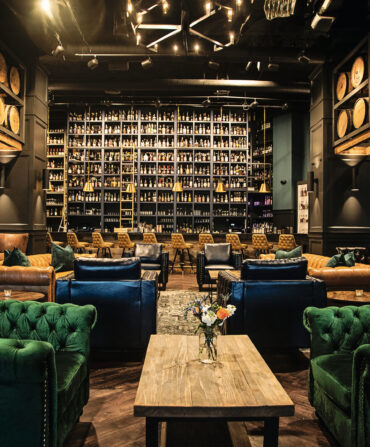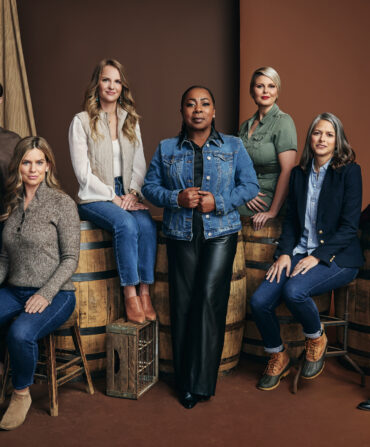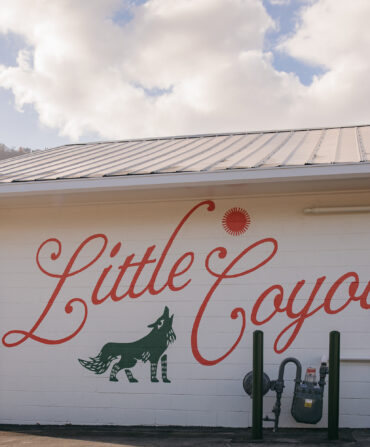Food & Drink
Michael Twitty: The Antebellum Chef
Michael Twitty doesn’t just want you to know the history of Southern food. He wants you to taste it
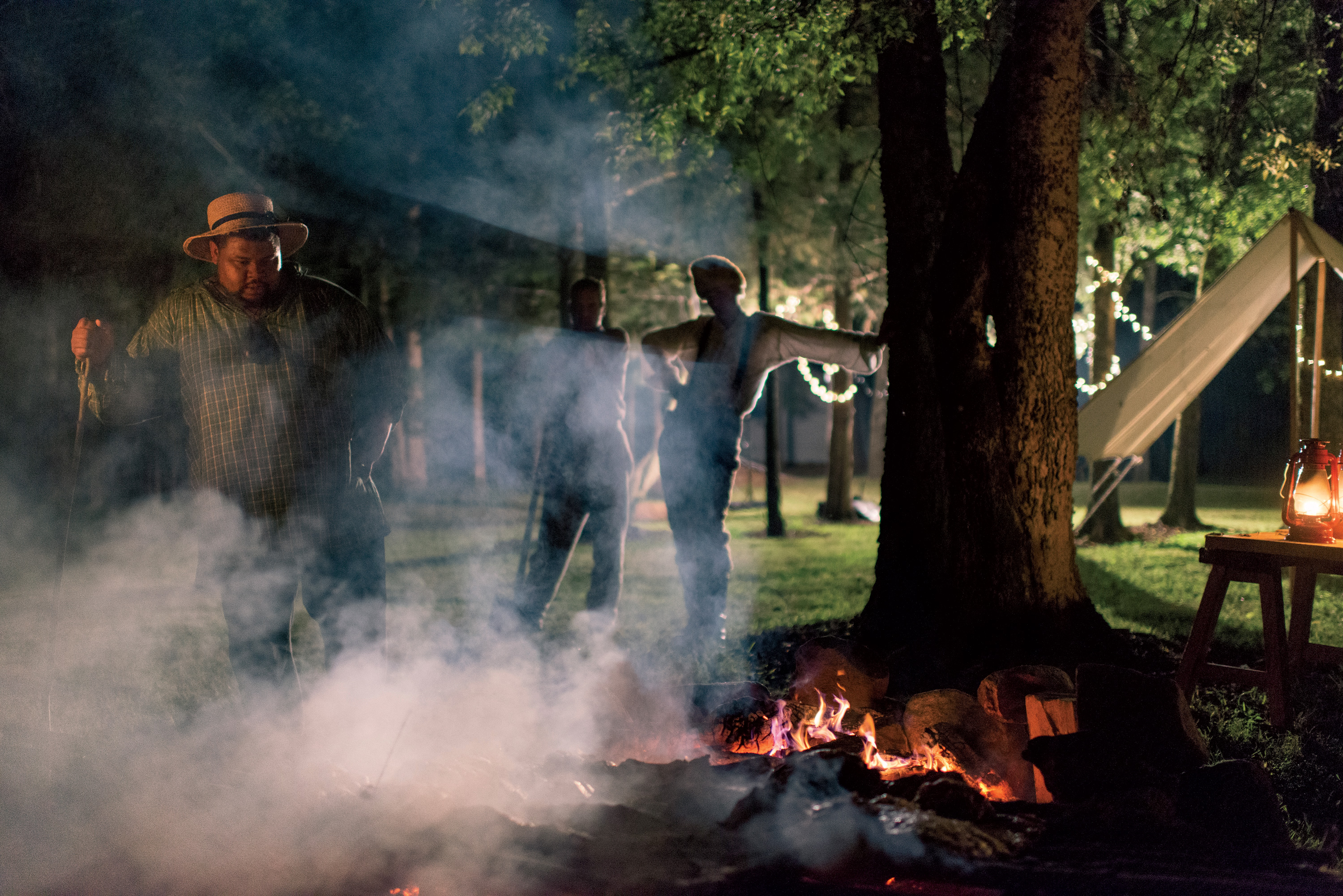
Photo: Andrew Kornylak
Smoke Signals
Twitty tends the fire pit during a long night of cooking at North Carolina's Stagville Plantation.
Michael William Twitty is worried, but he does not let it show.
The original plan was for no one to talk to the historical slave interpreters as they went about their work, but that plan has gone out the window. The men and women in eighteenth-century garb are surrounded by curious visitors milling about, asking questions, tasting food, getting in the way. It is midday and Twitty must serve a fund-raising meal for fifty people in less than six hours. Talking will slow everyone down. And there is so much cooking left to do.
This event had been Twitty’s brainchild for years: a benefit dinner at the remaining original slave quarters, known as Horton Grove, on one of the largest working plantations North Carolina had known: Stagville. Nine hundred enslaved men and women. Over thirty thousand acres. Controlled by one of the wealthiest families in pre–Civil War America. The meal would be prepared in the style and manner of the era, out of doors, as close as practicable to what the black folk of the time would have eaten. But more: The experience was meant to educate and excite and draw interest to the lives of the enslaved.
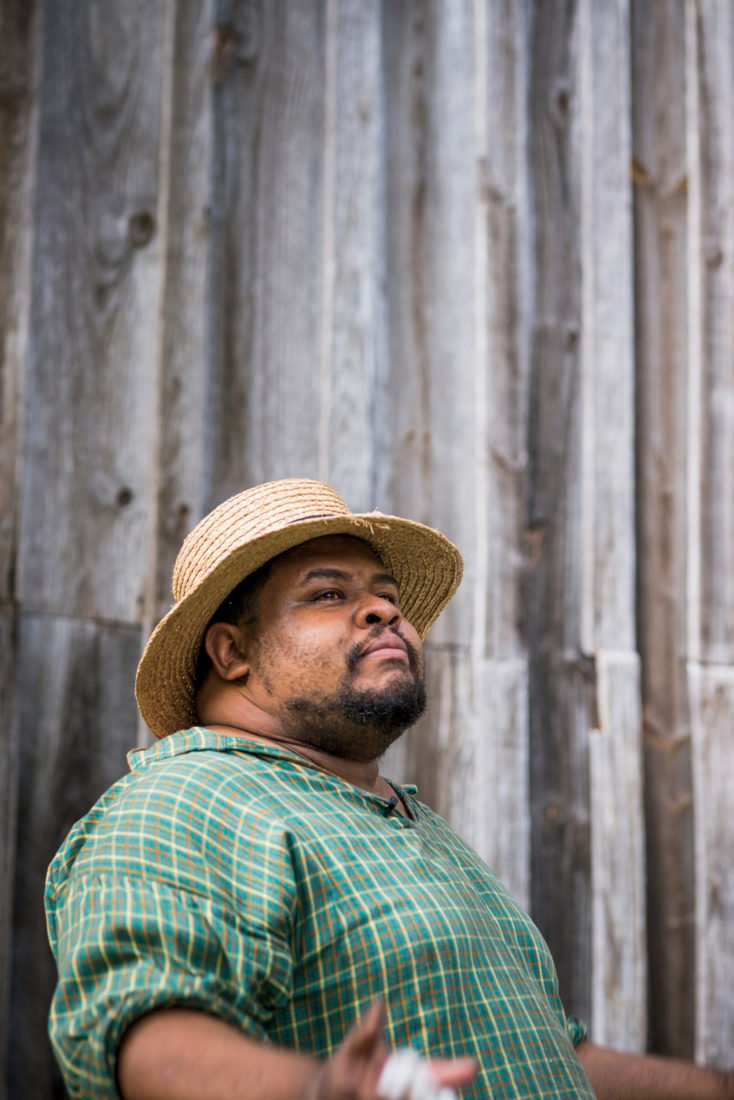
Photo: Andrew Kornylak
Twitty outside the original slave quarters at Stagville.
A teacher, writer, cook, culinary historian, historical interpreter, at thirty-six, Michael Twitty is a man of many parts. The more you learn about him, the more his complications seem to sprout complications. Yet he embodies them all with a certain protean gravity. “I am large, I contain multitudes,” Walt Whitman once wrote. Could the bard have anticipated Twitty? This big, healthy, good-looking, robust, heavy-footed, pirate-bearded brown bear of a man. Gifted with gab, he is a natural communicator who is not afraid to use all his voices.
Twitty has been up all night, with only one hour of sleep, having begun at nine o’clock the prior evening, roasting pork shoulders on a rack of sapling trees. Smoke billows. At the moment his voice is in danger of going.
The state of North Carolina has invested a significant amount in keeping the nucleus of the old plantation intact. The big house—not a romantic Georgian from Gone with the Wind fantasies, but a simply constructed, irregular, hulking dwelling—draws thousands each year. But perhaps even more outstanding is that four of the original slave quarters remain standing, the largest having housed four families in four smallish rooms on two floors. Rustic and dun, their austere presence almost belies the clear September skies and the tall trees.
The meals are being cooked in open pits only yards in front of the quarters. Whitman aside, this event has turned into a very curious and exciting twenty-first-century affair. The old place is a hive of activity. Indeed a postmodern mix of activity: cameras…chopping wood…video…iron trivets resting in fire and ash…smoke and flame…cell phones…a tour by a UNC archaeology professor explaining the history of the grounds, and the way the enslaved lived…a kids’ tasting table…sweet potato biscuits…samples of pies made the old way, with little sugar, lemony and tart and a bit bracing for the Food Lion palate—apple, peach, berries…roasting pork and frying chicken in the air…
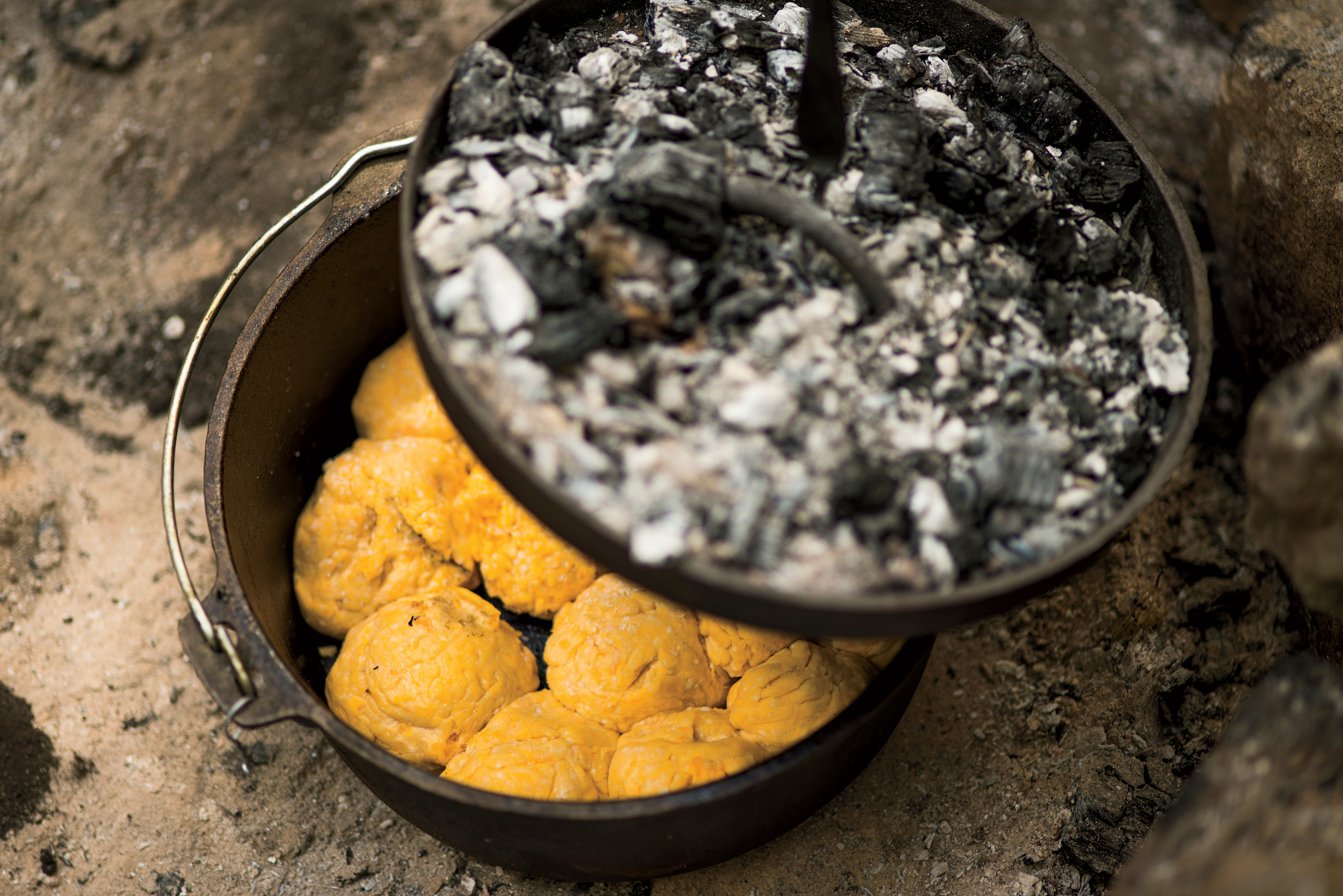
Photo: Andrew Kornylak
Sweet potato biscuits cooked over the open fire.
Just after noon Twitty takes a planned break, and the chef Hugh Acheson joins him for a discussion with the many visitors. A Canadian by birth, Acheson has made the South his adopted land and adopted culture, with award-winning restaurants in Georgia and cookbooks about Southern cuisine. His fame as a Top Chef judge has given him an even bigger megaphone.
A crowd joins them under a towering, shady old pecan tree. A healthy mix of black and white. Children are playing off to the side, and the gathering feels rather like a summer party, which it is.
Twitty talks about the cooking techniques they are witnessing. Using these open fires and wood and eighteenth-century tools, “we can do everything you can do in a modern kitchen—except microwave.”
Twitty and Acheson address the history of Southern food, the myths, the paradoxes, the looming shadow of race and food mingled; our modern-day notions about health and nostalgia and food, food, food.
Acheson: “It’s a maligning of our diet, this age of convenience. Southern food is viewed as unhealthy, but it doesn’t have to be. It’s time to focus on the goodness and seasonality—moderation. Bad food is bad food.”
Twitty humorously addresses the idea of how complicated issues of food and health are among African Americans, and why their physical welfare is distinct from that of both white Americans and West Africans. He talks about theories of a genetic clue to the plight of diabetes and high blood pressure among American black folk, something perhaps even linked to the experience of the Middle Passage and how individual slaves were chosen. Complicating the matter even more was the mixing of African and European DNA. The result being “African butts, European guts.”
“We need to learn to forgive ourselves,” he says.
He calls what African Americans have accomplished with food “edible jazz.”
For students of African American history, of Southern history, of American history, Twitty’s message is not exactly new or controversial. But for many Americans who cling stubbornly to tribal notions of a distinction between black and white, this whole-cloth history may seem brand-new, even shocking. Our schools have become such a failure at teaching history that most white Americans know little, if anything, of African American history, and of the origins of much of their foodways and folkways. Black foodways, white foodways, Southern foodways—they are all the same, blended, brothers and sisters. This is Michael Twitty’s core message.
Back to work. Back to the ash and the hot pots on the fire, back to the cameras, back to answering questions, back to making sure everything is on schedule, back to chop more wood.
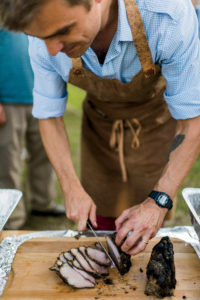
Photo: Andrew Kornylak
Chef Hugh Acheson pitches in.
Acheson chips in, apron on, slicing pork shoulder.
At one point Twitty is bent over the fire pit, lifting up a heavy-looking pot; he is sweating profusely. Two cameramen approach and ask him to hold still and Twitty says, “You guys love taking pictures of sweaty black men, don’t ya?”
Food triggers memory, Michael Twitty says. The summer of 2013 was marked by many media events: a new pope, Syria, the iPhone 5S, the fiftieth anniversary of the March on Washington. But one milestone shall undoubtedly remain the public meltdown of the celebrity Southern chef Paula Deen, queen of fried nostalgia and all things y’all. A civil lawsuit filed by one of her ex-employees led to the revelation in June that the Food Network star had, once upon a time, employed the n word in her kitchen. America and its media launched cruise missiles toward Savannah. Major Deen endorsement deals and television shows were dropped like proverbial hot rutabagas, and the name Paula Deen became an emblem for a new type of racial intolerance and insensitivity. Old-fashioned bigotry in a new age.
On June 25, a little-known food historian and historical interpreter wrote on his blog an open letter to the battered butter baroness: “So it’s been a tough week for you…believe me you I know something about tough weeks being a beginning food writer and lowly culinary historian.” Twitty—in a style that has become his own: comfortable, familiar, confessional, knowledgeable, humane—does not scold Paula, but instead takes the opportunity to help educate her, and a mock-shocked America. The real problem, Twitty explains, is not “a few paltry words like racism, bigotry, prejudice…” “We have a million and one ways to hate, disdain, prejudge, discriminate.” Twitty takes a path less taken in lamenting, instead, the lack of opportunities in the culinary world for people of color and the prevailing ignorance about the roots of American cultural foodways.
In the end he invites Deen to join him at a fund-raiser in September, at a historic antebellum plantation in North Carolina. Come cook with us, Paula. Come see for yourself.
The Huffington Post reposted the blog, followed by a large number of other websites, which led to link after link, and Tweet after Tweet, and in the twinkling of an eye the name Michael Twitty had become a media presence. His civilized response engendered much more interest than any ranting and raging and name calling could have; Twitty touched a live nerve.
On his blogs—Afroculinaria and The Cooking Gene—he writes about his obsessions with the roots of African American and Southern food history, about his personal journeys. He writes about his Southern Discomfort Tour, a series of trips in the South to uncover overlooked, underappreciated, and sensitive historical truths. He writes: “To my fellow African Americans—we complain a lot when sites and shows and movies and the like don’t reflect our history or experience. We want them to tell it like it is…but many of my colleagues have complained that so often we don’t empower each other to tell our own stories.”
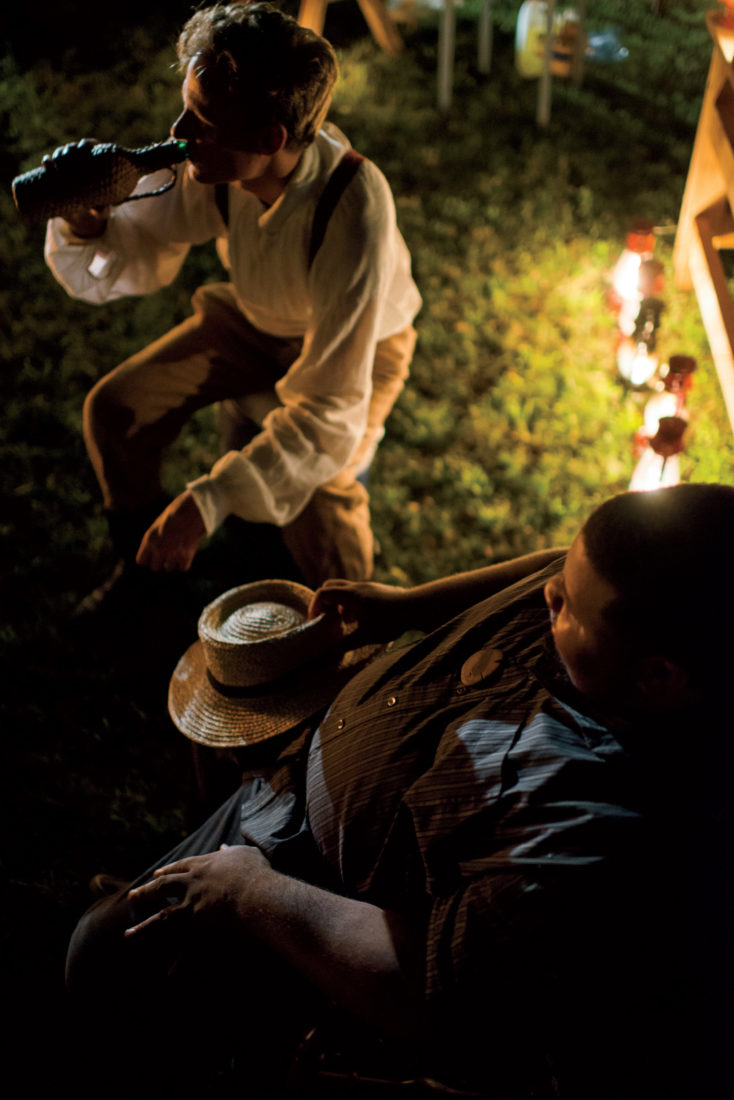
Photo: Andrew Kornylak
Living History
Twitty takes a break from midnight cooking with Ernest Dollar, president of the Historic Stagville Foundation board.
Michael Twitty is a Jew. He converted at twenty-two years old. Though he had been raised in an established Protestant tradition—his mother had gone to black Lutheran churches; his father was Baptist—and appreciated the culture of the African American church, the religiosity did not penetrate him.
It makes a certain sense that Twitty would identify more with the Sephardic tradition of Jewry, so full of ceremony and mystery and talismans. A religion of the Fertile Crescent and dusky-skinned people, in the shadow of pharaonic Egypt and towering Persia.
Twitty credits his maternal grandmother, who died when he was thirteen, with his Afrocentric passions: “It’s all due to my grandmother. She was a Race Woman. She was serious, too. She instilled in me: We are the people. And we still are the people. And we are sacrosanct. You meet someone from Guyana, Ghana, Brixton, Paris, Brazil—they are your family.” He was brought up to honor the broad African Diaspora as one organic thing, the seeds of Africa growing throughout the world, not unlike the way the Jewish Diaspora thrived through the years across continents. He remembers cooking side by side with his mother and grandmother while growing up in D.C., and though he did not always appreciate Southern fare (“When I was a little, little boy I hated a lot of that stuff. I hated black-eyed peas, I hated collard greens, I hated okra. I hated all of that. And that stuff smelled. It was different”), he soon grew to love it.
His maternal grandmother and grandfather were originally from Alabama. His grandfather taught him to prize learning. A cosmopolitan figure, a World War II veteran, and a negotiator for railroad unions, he traveled Africa and Europe on business. “Very professorial. Very bookish. Papers everywhere, books everywhere. He liked me because he could talk to me about these things, even though I was younger. He liked teaching me things.” Twitty considers these elements his building blocks, a natural progression, organic.
Courses in African American studies at Howard University. Developing presentations and exhibits for the Smithsonian Folklife Festivals. Stints at Colonial Williamsburg as an interpreter of African American colonial life. Working for the Maryland Humanities Council Speakers Bureau. Teaching Judaics and Hebrew for over ten years at six Hebrew schools (“a well-paying part-time job”), mostly to middle and early high school students. And yet Twitty found himself casting about for a clearer path for his interests. “I kept waiting for someone to bless me. Anoint me. Ordain me. So I just said, I’m going to do what I’m going to do.”
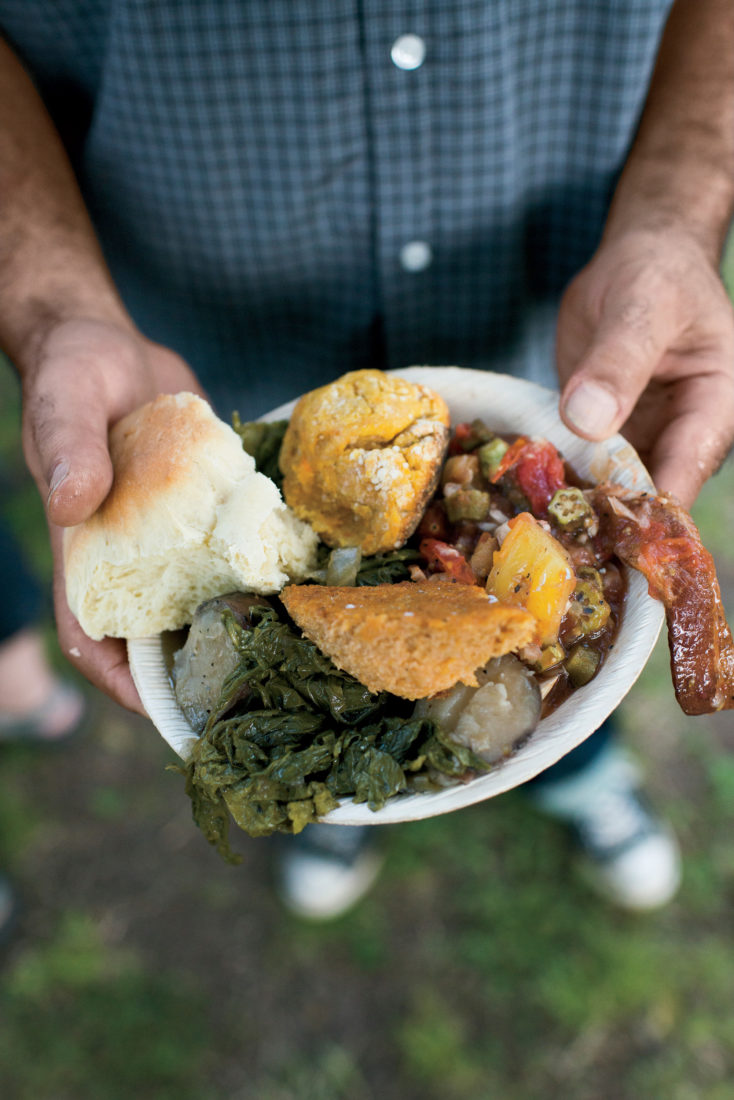
Photo: Andrew Kornylak
Edible Roots
A guest holds a plate of sweet potato pone, okra stew, greens, and more.
His new visibility post-Deen quickly caught the attention of René Redzepi in Copenhagen, chef of Noma, voted Best Restaurant in the World three years in a row. Redzepi is also one of the organizers of MAD—described as “a community of chefs, cooks, and farmers with an appetite for knowledge”—which holds a truly international symposium each year in Denmark. Twitty calls it the TED of food. Redzepi invited Twitty to come speak back in August. “When you go there, it’s the bad boys of food, like a Lollapalooza, a chef Burning Man,” Twitty says. “What they are doing is what I am doing, challenging the status quo. It was very intimidating.” Twitty’s talk before this hard-core food crowd received a standing ovation. Now he is under contract for two books on culinary history and increasingly in demand as a speaker, chef, and interpreter. His road seems well lit and clear.
Michael Twitty is wearing a straw hat. He does not look like a man who has been up all night and has prepared a banquet for fifty, outdoors, in a largely early-nineteenth-century fashion. Some might find characterizing Twitty’s presence, performance, manner, style, as that of a preacher to be too easy. Too much of a stereotype or a cliché.
But Twitty embraces the affect and the tradition. In fact he loves being what his mother decried as “an NBP: a Natural Born Preacher.” Which, when you think about it, chimes with his overall thesis of being. More important: He is so very good at it.
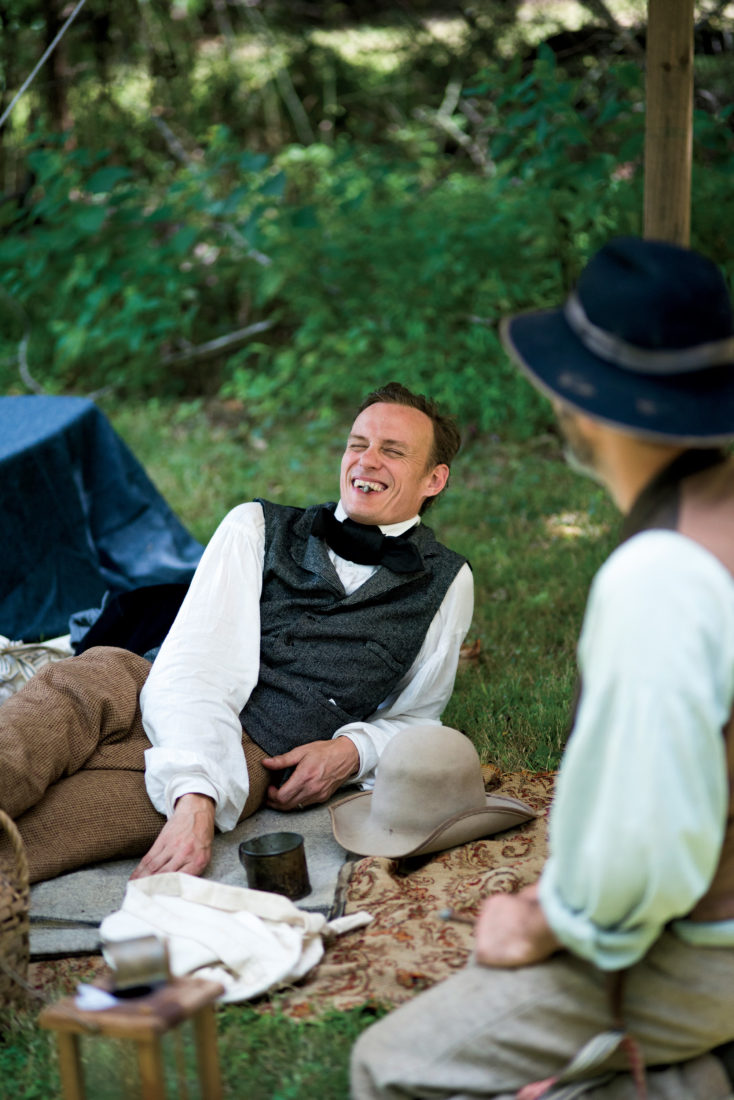
Photo: Andrew Kornylak
Hand-crushed coffee after a night of cooking.
Everyone is seated at tables under the grand trees, among the kempt relics of the quarters, an hour or so before twilight. It feels like a picnic. Casual. Yet here are dignitaries, food folk, scholars; the mayor of Durham, Bill Bell, an African American. Justin Robinson, ace violinist, late of the Carolina Chocolate Drops, has just played a melancholy interlude for the gathering prior to the supper.
But before the gathered hear the blessing of a minister and dig into the food, Twitty stands before the tables and is joined by Gina Paige, the president of African Ancestry, a company Henry Louis Gates, Jr., made famous in tracing DNA lineage for Americans. Six weeks earlier Twitty’s cheeks were swabbed. He intends to discover who his ancestors were. He has always considered this discovery as part and parcel of his vision for this evening.
The test was done at the Am Kolel Sanctuary and Renewal Center in Maryland, the home of his favorite rabbi, David Shneyer (“my Jewish dad”).
“I wanted to take the test in a sacred place, and receive the results in a sacred place,” Twitty says. “And I wanted the two sacred places to reflect different parts of my identity. The rabbi asked me to take a blessing before I took the test. I felt all the pieces were there. I have always been fascinated by the idea of fate and destiny and predestination. Full circle.”
First, Paige announced that Twitty’s maternal line descended from the west coast of Africa. The Mende. From what is now Sierra Leone. She said there is strong evidence that some of his ancestors were on the commandeered slave ship Amistad. Before delivering the news about the paternal line, Paige teared up a bit, got a catch in her throat. “Ghana,” she said. “Your father’s line goes back to the Akan people.” As a young man, Twitty had grown close to a Ghanaian gentleman, Kenneth Obuba, an Akan, who had been an important mentor for him.
“The word emotional isn’t right,” Twitty says. “It hit me, when the food all came together. It was stressful. But when everything came together, I started to see the truth of the moment. First of all, how many Southern history plantations have I been to where all the emphasis is on the architecture, the fixings, the furnishings, the ambience? We were an afterthought. Here the focus was on the quarters, the people who lived in them. The stories the land had to tell. And here we were, all us interpreters, under the age of forty-five, running around, dressed in historic clothing, duplicating the culture as best we could, showing people. And I felt an enormous sense of spiritual connection.”
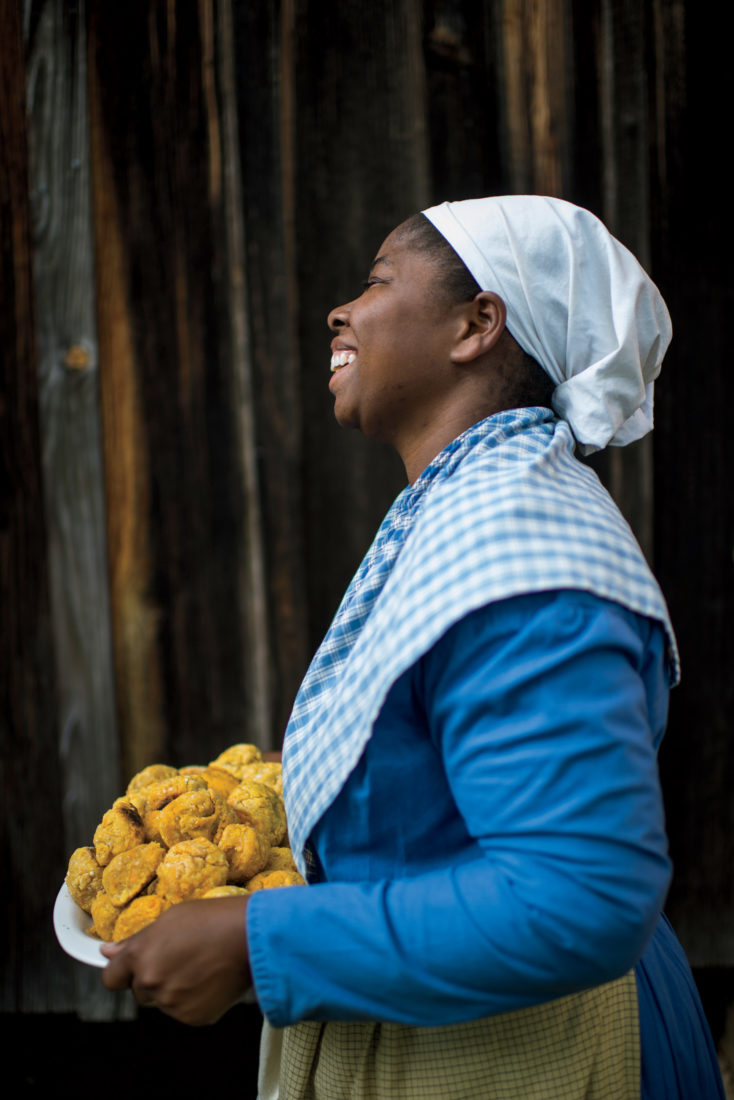
Photo: Andrew Kornylak
Historic interpreter Nicole Moore brings out the biscuits.
Cervantes once wrote, “Hunger is the best sauce.” But this meal is smothered in something much more satisfying. Ribs, pork shoulder, okra soup with tomatoes and onions and turkey wings—a gumbo of sorts—fried chicken, turnip greens, collard greens, sweet potato pone, coosh (a stuffing-like mixture of bread and meal), cornbread, biscuits. Pies of sorghum, peach, apple. All so very robust, strongly spiced—familiar to a born-and-bred Southerner—fulfilling after a long day of smoke and anxiety. One might even dare call it soul food.
At least 90 percent of the food has been sourced from North Carolina farms, and from African American farmers whenever possible. Twitty relies heavily upon the WPA slave narratives to duplicate the methods and mixtures. They did not use “recipes,” Twitty says. It’s just “fixing stuff.”
To be sure, enslaved people rarely—if ever—ate so well. They would have eaten offal: pig feet, chitlins, chicken feet, hog maws, hog’s head, pig ears. They would have eaten game they caught: possum and raccoon and squirrel and quail and deer and sometimes even rats. Twitty readily admits the fare would have been much harsher, “hoecakes, ash cakes.”
“Plus, if I gave you the authentic, real deal, some of that stuff is horrific. It would not pass muster. The original slave food? Oh no, honey. You find frequent references to eating meat that had been molded over, frequent references to flour with weevils living in it and no way to get them out, or even meager rations in the big house—there might be some leftover ham, a few potatoes, cornbread and sweetbread and milk mixed up. And that’s the people living in the house with the marble! Would that be good enough for twenty-first-century eaters? So let’s be real.”
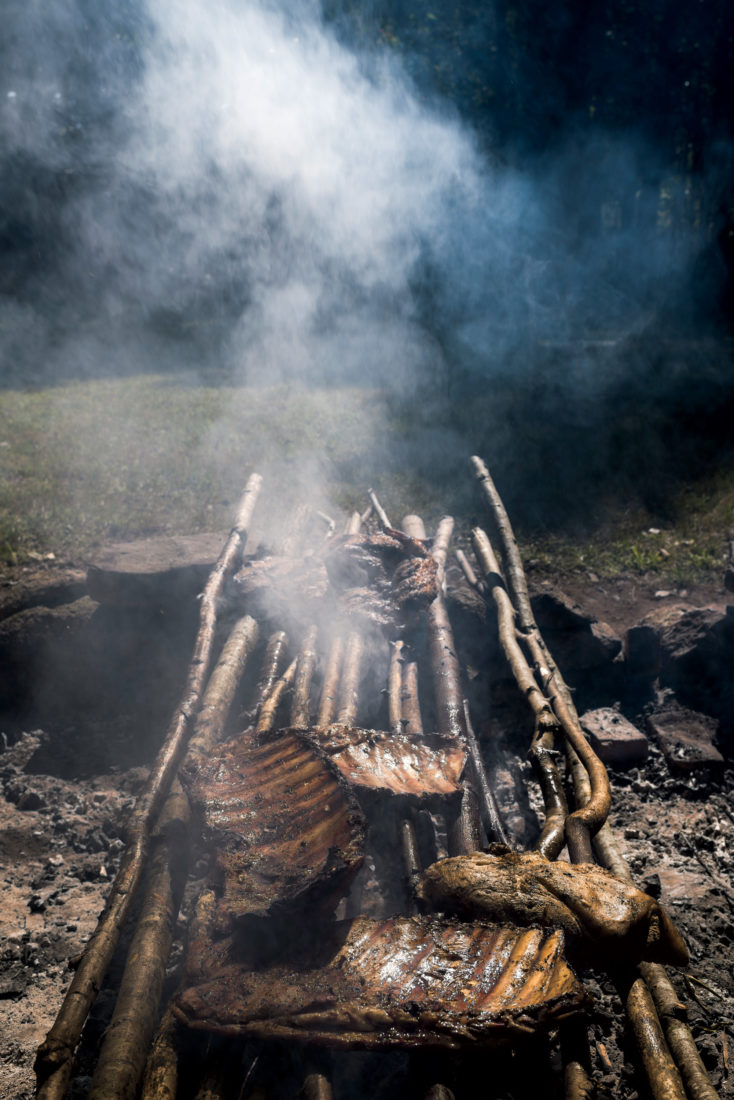
Photo: Andrew Kornylak
Meat roasts over hardwood saplings.
Michael Twitty is comfortable being described as a mystic.
He wears at his side, from his belt, what he calls a ditty bag. A black leather pouch that dangles. Some once called such a thing a nation sack. It is a custom Twitty learned about while working at Colonial Williamsburg.
What’s inside? Odds and ends, he says. Eighty or more things. He’s not supposed to say what’s inside. Special objects. Medicinal things. Good luck things. Healing things. Different parts…the claws of one of his late dogs…effluvia…ceremony and mystery and talismans…
“You can cook the food all you want, but you don’t know the spells that go with it,” he says. “Black folks could talk to objects, we talk to fire, we talk to spoons, we’ve been known to pray over things. Cooking was timed to the singing of spirituals. That’s imparting ase [Yoruba spiritual force] to the food. You ain’t nothing without the spirits that gave it to you. You have to have reverence. If it doesn’t have reverence, it ain’t got no flavor, it ain’t got no spice, it ain’t got no soul.”


